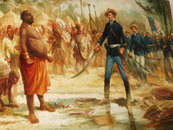In the late 1400s when the Portuguese invaded Kongo land, an alliance was bound to occur. The two civilizations blended seamlessly together living as one cohesive race. Nzinga later baptized to the name Joao, was in rule when the Portuguese empire came in contact with Kongo kingdom. When he and the ruler of the Portuguese united, they decided upon several factors that greatly affected the empire and kingdom. The main goal of the Portuguese was to spread Christianity, and their success in doing so led to their strong alliance. Together they developed a trading system which accounted for most of the kingdom’s wealth. The Portuguese traded their European and Asian linens for the Kongo’s hides, copper, and sugar. Their strong relationship sculpted the history of the Kongolese,but the Portuguese empire was indirectly the main cause of the Kongo decline. Eventually the African kingdom started to ship over slaves to Europe because the Portuguese would no longer accept payments in ivory, iron, and other various items like raffa cloth. Unfortunately while trading slaves for goods, some free slaves were shipped over to Portugal. The first incidents were honest mistakes, but soon after free slaves were purposely being shipped over because the demand could not be satisfied. These incidents of slavery led to a loss of trust between the civilizations. This distrust upset many citizens and caused rifts in the kingdom. Rifts, and internal struggles like succession problems eventually led to the fall of the once great Kongo kingdom.
Slave trade like succession became serious issues within the Kingdom of Kongo. The social ladder of Kongo was separated into three main categories. At the top was the court, who were essentially aids to the king. These aids were people like provincial governors who were given tasks by the king. The middle class was comprised of 2 groups of people. The civilian population were among the middle class as well as the free slaves. Those two sub groups were the major components of the middle class. Free slaves differ from regular slaves in the sense that free slaves were no longer slaves and technically could be classified as civilians but were put into a separate category. The lowest peg on the totem pole were “regular” slaves. Slaves were generally minorities within the Kongo population. At first slave trade was not a main export for Kongo but as the Portuguese worked their way into the government, slave trade became more and more in demand. The first place slaves were sold to was the Atlantic sugar island. Unfortunately though slave trade was a very lucrative business and the trade of slaves caused many issues within the government leading to the end of the Kingdom of Kongo.
-Eden Anonye and Madalynn Williams
Slave trade like succession became serious issues within the Kingdom of Kongo. The social ladder of Kongo was separated into three main categories. At the top was the court, who were essentially aids to the king. These aids were people like provincial governors who were given tasks by the king. The middle class was comprised of 2 groups of people. The civilian population were among the middle class as well as the free slaves. Those two sub groups were the major components of the middle class. Free slaves differ from regular slaves in the sense that free slaves were no longer slaves and technically could be classified as civilians but were put into a separate category. The lowest peg on the totem pole were “regular” slaves. Slaves were generally minorities within the Kongo population. At first slave trade was not a main export for Kongo but as the Portuguese worked their way into the government, slave trade became more and more in demand. The first place slaves were sold to was the Atlantic sugar island. Unfortunately though slave trade was a very lucrative business and the trade of slaves caused many issues within the government leading to the end of the Kingdom of Kongo.
-Eden Anonye and Madalynn Williams

